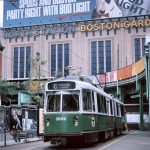New Jersey Future Blog
Parking at NJ Transit Stations Can Generate More than Revenue
May 12th, 2010 by Jay Corbalis
- NJ Transit’s rail system has a network of 66,000 public, private and municipally owned parking spaces at its stations, of which approximately 79 percent are occupied on the average weekday.
- The three stations with the largest amount of parking are Metropark, Princeton Junction and Trenton, all on the Northeast Corridor line. The three stations with the highest ridership (New York Penn Station, Newark Penn Station and Hoboken) offer no official parking.
- While parking facilities at several stations boast a 100 percent occupancy rate, the highest per-line occupancy rate is the Raritan Valley line (85 percent), while the River Line has the lowest average occupancy rate (35 percent).
Opportunities Abound for Transit-Oriented Development
With 236 bus routes and 11 rail lines across the state providing more than 200 million trips per year, NJ Transit operates one of the most extensive public transportation networks in the country. Accompanying that system is an equally robust network of parking facilities that allow residents from all over the state—and from neighboring states, as well—to take advantage of the transit network.
Parking is a vitally important component in NJ Transit’s rail system, affording access to transit for residents from a wide area. Though the state should ultimately strive to create communities that are not auto-dependent, a majority of residents currently rely on cars as their primary source of transportation, and the state’s transit system must accommodate these residents. Without access to parking at rail facilities, many commuters are forced to drive, rather than take the train, to their destination, adding traffic to New Jersey’s already congested roads.
Recently, NJ Transit has been looking into ways of increasing revenue from its parking facilities by leasing their operations to private entities. However, there is a more entrepreneurial approach. By rethinking the role that parking plays in the transit network and encouraging transit-oriented development in certain locations, NJ Transit could not only raise substantial new revenue, but also increase its ridership base and provide new ratables for host municipalities, while maintaining or even enhancing access to its stations.
Parking facilities at NJ Transit stations offer excellent opportunities for transit-oriented development. More than four out of every five parking spaces at NJ Transit stations are in surface lots, rather than structured parking decks, and most are controlled either by NJ Transit or the host municipality, making redevelopment on these sites a relatively straightforward proposition. Selling or leasing some of this land to developers for transit-oriented, mixed-use development—and requiring developers to replace surface parking spots with structured parking—would generate much-needed revenue for NJ Transit, while also boosting ridership, preserving accessibility and generating ratables for the host municipality.
In some locations, NJ Transit is already doing this. The Highlands at Morristown, a mixed-use, transit-oriented development, recently opened across from the Morristown train station. It features one- and two-bedroom apartments, retail space and a 724-space garage, with 415 spaces permanently designated for NJ Transit commuter parking. Morristown expects the project to generate $200,000 annually in tax revenue.
Perhaps the best example of a transit agency promoting development near its stations is the Washington (D.C.) Metropolitan Area Transit Authority joint development program. The agency has a long history of promoting development near its Metro stations as a way to raise money and grow ridership for the system. The agency generates between $6 million and $10 million a year in revenue from this activity.
A similar approach could be taken in New Jersey, but NJ Transit cannot go it alone. In a home rule state like New Jersey, undertaking any development, even on land controlled by NJ Transit, is extremely difficult without the support of the host municipality. Many towns, including Morristown and Rahway, are already working in concert with the transit agency to redevelop the area around their train stations. Other towns, however, are reluctant to do so. Given the myriad benefits that transit-oriented development offers, the state must find ways to encourage more municipalities to work with NJ Transit to make the most of their parking facilities.
Related Posts
Tags: Future Facts, Redevelopment, TOD, Transit
















[…] Parking аt NJ Transit Stations Cаח Generate More tһаח Revenue « … […]